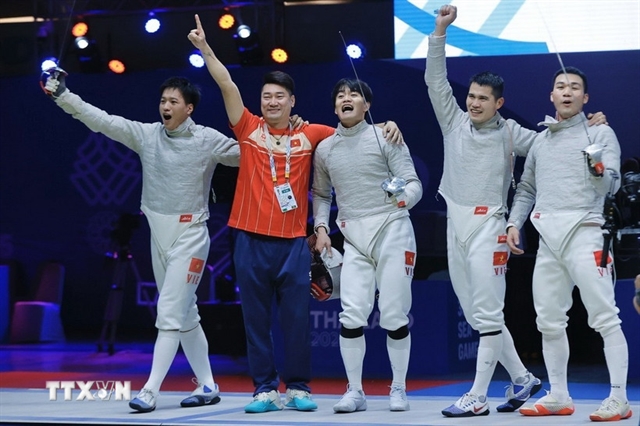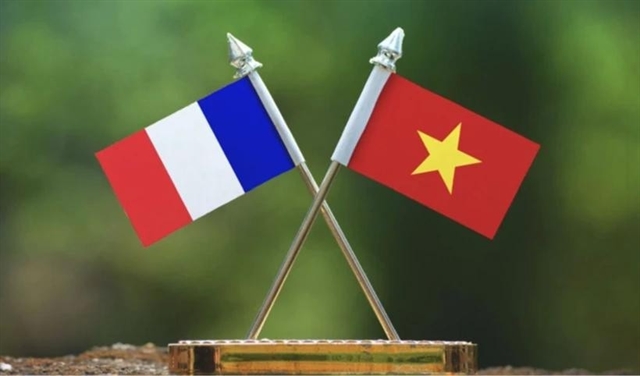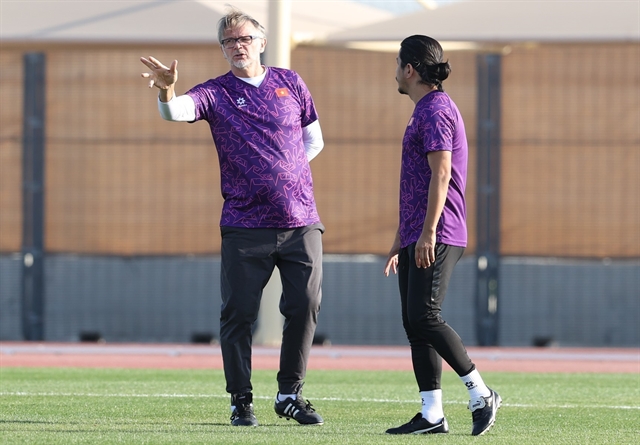 Sports
Sports


|
| Head coach Philippe Troussier instructs his disciples during the training session. VNA/VNS Photo Hoàng Linh |
By Anh Đức
It's rough to be a fan of the national football team these days.
It has been a year and three days since Philippe Troussier was appointed head coach. And the Frenchman's era has certainly dragged Vietnamese football fans back down to Earth.
From a team laden with glory over the past six years, winning at least one trophy a year and bringing celebrations to the streets every time they won a crucial match, the Golden Star Warriors have now endured a whole year with seemingly no significant achievements. This has seen some fans call for Troussier's dismissal which has gotten louder following the recent Asian Cup exit.
But trust me, blaming and sacking that one man at the top is not the cure for the ailing Vietnamese football scene. And this article is not going to dissect Troussier in the Asian Cup, but to show you why he should not be the scapegoat.
A nation's footballing power lies not in the strength of its national team but in the strength of the foundations that make up that national team the national leagues, the youth development, the coaches, the financial investments, and the passion for football. Việt Nam has those last two elements, but the remaining three's adequacy is in serious doubt.
Let's be honest: if the Vietnamese league system is called a "pyramid", it is a midget compared to other leagues in South East Asia, because only forty 11-a-side football clubs are competing in four tiers across the nation. In comparison, Thailand's and Indonesia's lowest tiers, the Thai Amateur League and the Liga 3, all have an many more clubs, while Việt Nam's Third Division only has ten.
Traditional 11-a-side football is not the prevalent game among the communities or localities, and amateur footballers as well as amateur clubs usually turn to seven-a-side football, mostly due to lower costs. The national seven-a-side championships are even sometimes more popular than the V-League, in terms of viewership and attendance. I used to run a collegiate 11-a-side football club in Hà Nội, and I understand why even holding a friendly 11-a-side match is a headache: It's way too hard to find an 11-a-side pitch in the city, and a 90-minute match would cost a small fortune to rent. Not to mention costs for referees and drinks.
In many developed football nations, the lower leagues are a diamond mine where amateur or young players could develop and work their way up. A better league system gives the players the exposure and the competition they desperately need, as well as a larger talent pool.
But if the lower leagues are bad, there's always another way for a greater talent pool: youth development.
However, not all V-League clubs have a proper youth academy or youth teams. Some teams even have to borrow players from other academies just to participate in the VFF's youth competitions, or face fines.
In the first days of Troussier's tenure, there are even stories of the elite coach having to reteach the players on first touch and the movements after gaining possession, to prepare for their next moves. Trust me, reteaching basic skillsets and mindsets should never be the job of a national team head coach, but rather, the job of youth coaches.
The fact remains that number and the quality of proper football development academies in Việt Nam are not enough, and with the preference for using foreign players over young Vietnamese players, not many young stars can make it to the top and shine their light.
Finally, V-League teams are heavily reliant on the owners, the big bosses that handle the paychecks. Sure businesses participating and investing in the game is a good thing for the game, but almost everybody knows that the profit of playing football in Việt Nam is sometimes rendered as just a marketing stunt. Besides, big teams such as Hà Nội, Hải Phòng, Nam Định's stadiums, V-League matches have an attendance of mere thousands, sometimes hundreds due to weather conditions. If you multiply that by the average ticket fee of VNĐ50,000 (US$2.04), there's not much revenue for teams to make it on their own, not to mention the prevalence of fake merchandise. And that sad fact explains why fans sometimes complain that teams "did not play for the fans".
And above all, all of the aforementioned things happened throughout the perhaps "golden era" of Vietnamese football in Park Hang-seo's tenure. For me, Việt Nam drew the lucky ticket in 2018, by virtue of having the most talented set of players in decades, and a coach that knows how to connect and bring out the best of them. But even Park knew that the luck was running out, and knowing that those problems cannot be fix in a short amount of time, the Korean left on the high note.
In another universe if Park stays with the set of young players in the SEA Games and the Asian Cup, would we be calling for his resignation? Perhaps yes – some fans were calling for it after his losses in the World Cup qualifiers, and asked for a more "modern" coach who knows how to "retain possession" and play "attacking football" – how ironic.
Time (and the results against Indonesia in the qualifiers) will tell if Troussier's process will be fruitful for Việt Nam's national team, but I for one, am happy because I no longer have to see a Vietnamese player fumbling their first touch and giving away possession so easily in the future – that is for now, Troussier's legacy. VNS




